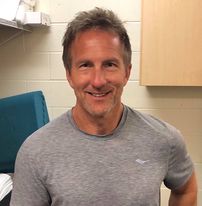Proximal Hamstring Tendinopathy: Todd’s Journey to Recovery
Introduction:
Meet Todd Charnetsky, a sports enthusiast from Green Bay, Wisconsin, who has been active in various sports throughout his life. In this blog, we’ll delve into Todd’s personal experience with proximal hamstring tendinopathy, a condition that plagued him for over a decade. Todd’s story is a testament to perseverance and trying different approaches until he found a path to recovery.
Todd’s Proximal Hamstring Tendinopathy Journey:
Proximal hamstring tendinopathy, often referred to as high hamstring tendinopathy, is a condition characterized by pain and discomfort in the upper part of the hamstring near the sitting bone (ischial tuberosity). It’s a common injury among athletes, particularly runners.
In 2007, Todd was training for a half marathon, one of his many running endeavors. Little did he know that this training cycle would mark the beginning of a long battle with proximal hamstring tendinopathy. Despite his background in exercise physiology and fitness, Todd pushed through the initial discomfort, thinking it would go away on its own. This decision would haunt him for years to come.
After undergoing the PRP procedure and witnessing some initial improvements, Todd was determined to continue his recovery journey. He focused on strength training and rehabilitation exercises to restore the functionality of his hamstring tendons.
Hamstring Tendon Strength Training
Despite experiencing some soreness, Todd incorporated strength training into his routine. He made careful adjustments to avoid aggravating the tendons further. His strength training regimen included exercises like squats, leg curls, and leg presses. He also incorporated eccentric exercises to challenge his hamstring tendons in a controlled manner. This approach aimed to promote tendon healing.
The progress wasn’t linear, but it was substantial. He reported feeling about 50% better than before the PRP procedure by late 2015.
Managing Daily Life
Todd’s journey also involved adapting to the realities of living with proximal hamstring tendinopathy. He continued to use pads and cushions to minimize discomfort while sitting. In many situations, he opted to stand instead of sitting, which became a habit he developed over the years.
Despite making significant strides in his recovery, Todd didn’t consider himself completely cured. The risk of tendon detachment remained a concern, and he recognized the importance of managing the condition carefully.
The Turning Point:
Experimenting with Different Approaches:
Over the years, Todd explored various treatments and strategies to alleviate his hamstring tendinopathy. One of the key turning points in his journey was his introduction to the H-Wave device, an electrical stimulator that facilitates muscle contractions without fatigue. Todd used it daily for two hours, ditching the conventional practice of icing.
Heat Therapy and Dynamic Stretching:
Todd also incorporated far-infrared heating pads into his routine to improve circulation and blood flow to the affected area. He replaced static stretching with dynamic movements, understanding that stretching was aggravating his condition rather than helping.
Strength Training and Glute Activation:
Todd emphasized the importance of strengthening the glute muscles to share the load with the hamstrings. Incorporating glute-focused exercises and prehab routines before runs became part of his strategy.
Continued Commitment:
Even though Todd has seen significant improvement and is mostly symptom-free, he remains committed to his recovery plan. He continues to use the H-Wave device, prioritize glute activation, and avoids icing.
Words of Wisdom for Those with Proximal Hamstring Tendinopathy:
Todd’s journey serves as an inspiration for individuals dealing with chronic hamstring tendinopathy. His advice includes:
- Try Different Approaches: Don’t give up; explore various treatments and modalities.
- Avoid Irritants: Steer clear of activities or treatments that exacerbate your condition.
- Commit to a Structured Approach: Test and tweak different strategies for a set period. If you don’t see improvement, try something else.
- Prioritize Glute Activation: Strengthening the glute muscles is crucial in sharing the load and supporting the hamstring tendons.
- Maintain Commitment: Even when you feel better, continue with your treatment plan to prevent relapse.
Conclusion
Todd Czarniecki’s journey with proximal hamstring tendinopathy spanned over a decade. During this time, he faced numerous challenges, from enduring pain and discomfort to managing daily life and seeking various treatments. While Todd’s experience showcases the difficulties of managing chronic conditions, it also offers hope and inspiration.
His story demonstrates the importance of a comprehensive approach to treatment, which includes medical interventions, targeted rehabilitation exercises, and lifestyle adjustments. Although proximal hamstring tendinopathy can be a challenging condition, Todd’s journey is a testament to the resilience of the human spirit and the potential for improvement and recovery.


